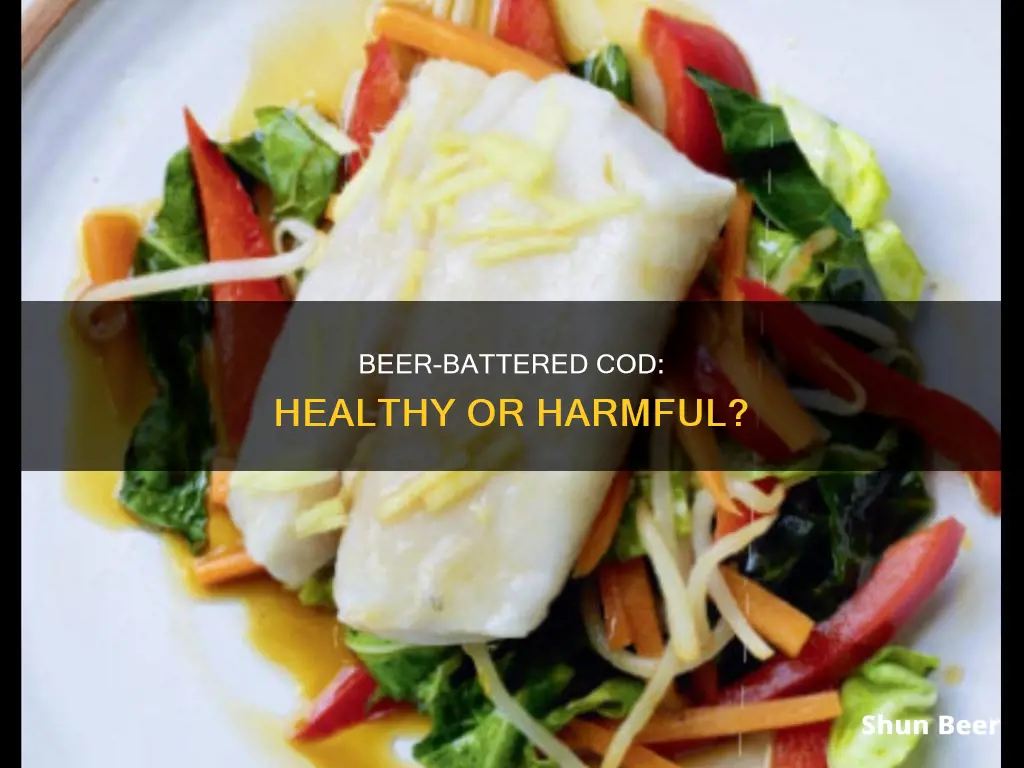
Beer-battered cod is a popular dish, but is it healthy? Frying fish reduces its omega-3 fatty acid content, which is the main source of its nutritional value. Frying also adds calories, especially when the fish is batter-fried, which can lead to weight gain and increased health risks. However, some cooking methods can make fried fish healthier. For example, using a sheet pan to bake the fish and chips instead of deep-frying it can result in a healthier version of the classic dish.
Is Beer Battered Cod Healthy?
| Characteristics | Values |
|---|---|
| Calories | A beer-battered cod fillet contains 444 calories. |
| Fat | Frying adds calories and fat, and can contribute to weight gain and increased health risks. |
| Omega-3s | Frying may reduce omega-3 fatty acids in fish. |
| Sodium | Fish and chips are heavily doused in salt and vinegar. |
| Healthier Alternatives | Baked or grilled fish is healthier than fried. |
What You'll Learn

Beer-battered cod is less healthy than baked or boiled fish
Beer-battered cod is a delicious treat, but it is less healthy than baked or boiled fish. While fish is a very nutritious food, the process of deep-frying it in batter can reduce its health benefits.
Frying fish in batter adds a lot of extra calories, which can contribute to weight gain and increase health risks. The batter itself is usually made with wheat flour, rice flour, and baking powder, which are not particularly nutritious. In addition, the oil used for frying can be high in unhealthy fats.
Furthermore, frying fish can reduce the omega-3 fatty acid content, which is one of the main sources of its nutritional power. Omega-3 fatty acids are essential for maintaining a healthy heart and reducing the risk of heart disease. By contrast, eating five or more portions of baked or boiled fish a week can reduce the risk of heart attack by 30%.
While beer-battered cod is a tasty treat, it is important to consume it in moderation as part of a balanced diet. Baked or boiled fish is a healthier option, providing the same protein and vitamin B12 content without the added calories and fat of the batter and frying process.
Porter Beers: Healthy or Unhealthy?
You may want to see also

Frying fish reduces omega-3 fatty acids
Frying fish, including cod, can significantly reduce the amount of omega-3 fatty acids in the final dish. Omega-3 fatty acids are important for optimal body and brain function, and their sufficient intake has been linked to a decreased risk of heart disease and some cancers.
When frying fish, the omega-3 fatty acids are exposed to high temperatures and oxygen, which causes them to break down. This breakdown results in a significant reduction of omega-3 fatty acids in the cooked fish. Research has shown that frying tuna, for example, can decrease the amount of omega-3 fatty acids by up to 70-85%. Similarly, another study found that frying altered the fatty acid profile of anchovies and sardines, changing it completely.
The negative impact of frying on omega-3 content is further exacerbated by the type of oil used. Cooking oils high in omega-6 fatty acids, such as vegetable oil, can increase the inflammatory omega-6 content in the fish. This effect is more pronounced in deep-fried fish due to the larger amounts of oil used.
Additionally, the high temperatures during frying can contribute to the formation of harmful compounds, such as heterocyclic amines (HAs) and polycyclic aromatic hydrocarbons (PAHs). These compounds have been linked to various diseases, including heart disease, diabetes, and Alzheimer's.
To preserve the omega-3 fatty acids in fish, it is recommended to opt for cooking methods such as baking, steaming, poaching, or even microwaving. These methods help retain the healthy omega-3 fatty acids and minimize the formation of harmful compounds.
In summary, frying fish, such as cod, can lead to a substantial reduction in omega-3 fatty acids due to the combination of high heat, oxygen exposure, and the use of certain cooking oils. To maximize the nutritional benefits of fish, alternative cooking methods are generally recommended.
Two Beers a Night: Healthy Habit or Slow Poison?
You may want to see also

Beer-battered cod is high in calories
The high-calorie content of beer-battered cod is further exacerbated by the addition of tartar sauce, french fries, coleslaw, and a bread roll. While the fish itself is nutritious, providing a good source of protein and vitamin B12, the deep-frying process reduces its omega-3 fatty acid content.
To reduce the calorie intake, it is recommended to bake or grill the fish instead of frying it. This healthier alternative can be achieved by using a sheet pan and oven-baking the beer-battered cod, resulting in a crispy coating without the excess calories.
While beer-battered cod is undeniably tasty, its high-calorie content underscores the importance of moderation and balanced eating habits. As part of a balanced diet, it is advisable to limit the consumption of deep-fried foods and opt for baking or grilling methods whenever possible.
Sour Beers: Health Benefits or Just a Tangy Treat?
You may want to see also

Battering with rice flour keeps the fish crispy
Beer-battered fish is a classic dish, but to make it perfect, you need to ensure the batter is light, puffy, and crispy. The secret to achieving this lies in the use of rice flour in the batter.
Firstly, let's understand why rice flour is superior to plain flour for this purpose. When using plain flour, the batter tends to become soggy within minutes, which is less than ideal for crispy fish. In contrast, rice flour is the key to achieving a super-crispy coating that stays crisp for a longer duration. This is a well-known technique in Asian cuisine, used in popular dishes like Honey Chicken and Sweet & Sour Pork.
Now, let's delve into the science behind it. Rice flour has a higher starch content than plain flour, and starch molecules absorb moisture, preventing the batter from becoming soggy. Additionally, rice flour cooks up crispier than plain flour, ensuring that your fish maintains its desirable texture.
When preparing beer-battered fish, it is essential to use a combination of rice flour and plain flour. This is because rice flour doesn't turn golden when cooked, so using only rice flour would result in pale, unappetising fish. By mixing the two types of flour, you get the best of both worlds: the crispiness of rice flour and the golden colour of plain flour.
To make the perfect beer-battered fish, follow these simple steps:
- Prepare your fish by drying and cutting it into the desired size.
- Create a rice flour coating by dusting the fish with rice flour and shaking off the excess.
- Make the batter by mixing rice flour, plain flour, baking powder, and salt. Add ice-cold beer and whisk until combined. The beer should be straight from the fridge, and any lager will do.
- Dip the floured fish into the batter, ensuring it is fully coated.
- Gently lower the battered fish into hot oil heated to around 190°C/375°F.
- Fry the fish for approximately 3 minutes, or until it is deep golden.
- Drain the excess oil on paper towels or a mesh rack.
By following these steps and utilising the power of rice flour, you can create a light, crispy, and puffy coating on your beer-battered fish that will stay crisp for longer. Enjoy your delicious, crispy fish!
Beer, Tomato Juice: Healthy Combo or Not?
You may want to see also

Beer-battered fish is best cooked in hot oil
Beer-battered fish is a delicious treat, but is it healthy? Well, it depends on how you cook it. Frying fish in hot oil is a popular method that can result in a crispy, golden brown coating. But is it the healthiest option?
When it comes to beer-battered fish, the key to getting that perfect crispy texture is to use hot oil. The oil needs to be hot enough to create a reaction with the cold batter, making the coating puff up and giving it that signature crispiness. If the oil isn't hot enough, the batter may fall off the fish, resulting in a soggy mess. On the other hand, if the oil is too hot, it can burn the exterior of the fish before the centre is fully cooked, leaving you with an unevenly cooked dish. So, it's important to get the oil temperature just right—around 365-375 degrees Fahrenheit is ideal.
To ensure your beer-battered fish turns out perfectly, there are a few other things to keep in mind. First, make sure the fish is dry before dipping it in the batter. This will help the batter adhere to the fish and prevent it from sliding off during frying. Second, don't overcrowd the fryer. Adding too many pieces of fish at once will drop the temperature of the oil, affecting the crispiness of your final product. Finally, use a cooling rack instead of paper towels or newspapers to drain the excess oil after frying. This will help maintain the crispy coating by preventing steam from forming between the fish and the coating.
By following these tips and cooking your beer-battered fish in hot oil, you'll end up with a delicious, crispy treat that's sure to impress. While frying may not be the healthiest cooking method, it's a tasty option for an occasional indulgence!
Hard Seltzer vs Beer: Which is the Healthier Choice?
You may want to see also
Frequently asked questions
Beer-battered cod is not considered a healthy dish due to the high calories and fat content. Frying fish reduces its omega-3 fatty acids, which are the main source of its nutritional value.
To make this dish healthier, you can bake or grill the cod instead of frying it. This reduces the calorie intake and preserves the nutritional benefits of the fish.
A healthy alternative is to oven-cook breaded cod with a light sprinkle of olive oil. This method retains the crispiness while being a healthier option.
For a crispy and puffy texture, use a combination of rice flour and plain flour in the batter. Ensure the beer is ice-cold, and avoid dark, heavily flavoured beers. Cut the cod into thin pieces for even cooking.







